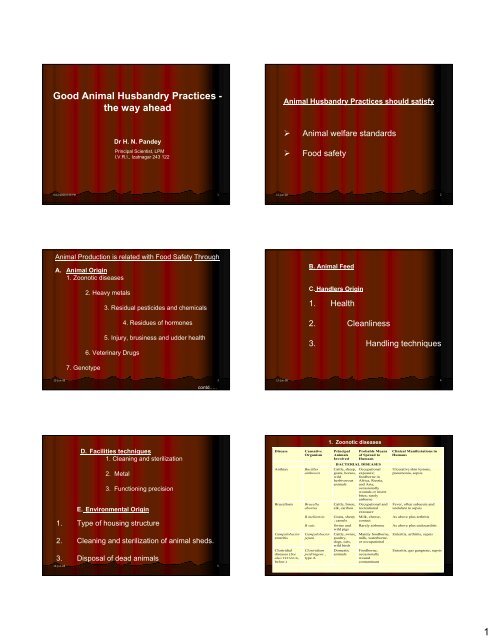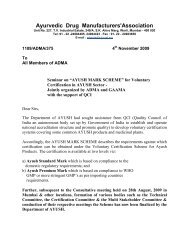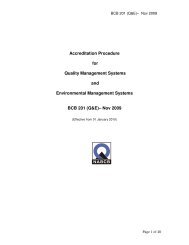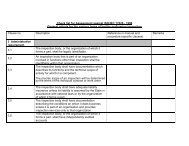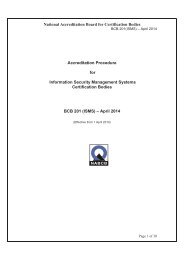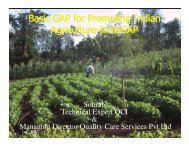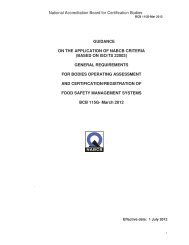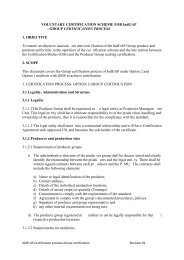1 Good Animal Husbandry Practices - the way ahead
1 Good Animal Husbandry Practices - the way ahead
1 Good Animal Husbandry Practices - the way ahead
You also want an ePaper? Increase the reach of your titles
YUMPU automatically turns print PDFs into web optimized ePapers that Google loves.
<strong>Good</strong> <strong>Animal</strong> <strong>Husbandry</strong> <strong>Practices</strong> -<br />
<strong>the</strong> <strong>way</strong> <strong>ahead</strong><br />
<strong>Animal</strong> <strong>Husbandry</strong> <strong>Practices</strong> should satisfy<br />
Dr H. N. Pandey<br />
Principal Scientist, LPM<br />
I.V.R.I., Izatnagar 243 122<br />
‣ <strong>Animal</strong> welfare standards<br />
‣ Food safety<br />
6/12/2008 8:26 PM<br />
1<br />
12-Jun<br />
Jun-08<br />
2<br />
<strong>Animal</strong> Production is related with Food Safety Through<br />
A. <strong>Animal</strong> Origin<br />
1. Zoonotic diseases<br />
2. Heavy metals<br />
3. Residual pesticides and chemicals<br />
4. Residues of hormones<br />
5. Injury, brusiness and udder health<br />
6. Veterinary Drugs<br />
B. <strong>Animal</strong> Feed<br />
C. Handlers Origin<br />
1. Health<br />
2. Cleanliness<br />
3. Handling techniques<br />
7. Genotype<br />
12-Jun<br />
Jun-08<br />
3<br />
12-Jun<br />
Jun-08<br />
4<br />
contd…..<br />
12-Jun<br />
Jun-08<br />
D. Facilities techniques<br />
1. Cleaning and sterilization<br />
2. Metal<br />
3. Functioning precision<br />
E. Environmental Origin<br />
1. Type of housing structure<br />
2. Cleaning and sterilization of animal sheds.<br />
3. Disposal of dead animals<br />
5<br />
Disease<br />
Anthrax<br />
Brucellosis<br />
Campylobacter<br />
enteritis<br />
Causative<br />
Organism<br />
Bacillus<br />
anthracis<br />
Brucella<br />
abortus<br />
B melitensis<br />
B suis<br />
Campylobacter<br />
jejuni<br />
Clostridial Clostridium<br />
diseases (See perfringens ,<br />
also TETANUS, type A<br />
below.)<br />
12-Jun<br />
Jun-08<br />
1. Zoonotic diseases<br />
Principal<br />
<strong>Animal</strong>s<br />
Involved<br />
Probable Means<br />
of Spread to<br />
Humans<br />
BACTERIAL DISEASES<br />
Cattle, sheep, Occupational<br />
goats, horses, exposure;<br />
wild foodborne in<br />
herbivorous Africa, Russia,<br />
animals and Asia;<br />
occasionally<br />
wounds or insect<br />
bites; rarely<br />
airborne<br />
Cattle, bison,<br />
elk, caribou<br />
Goats, sheep<br />
, camels<br />
Swine and<br />
wild pigs<br />
Cattle, swine,<br />
poultry,<br />
dogs, cats,<br />
wild birds<br />
Domestic<br />
animals<br />
Occupational and<br />
recreational<br />
exposure<br />
Milk, cheese,<br />
contact<br />
Rarely airborne<br />
Mainly foodborne,<br />
milk, waterborne,<br />
or occupational<br />
Foodborne;<br />
occasionally<br />
wound<br />
contaminant<br />
Clinical Manifestations in<br />
Humans<br />
Ulcerative skin lesions,<br />
pneumonia, sepsis<br />
Fever, often subacute and<br />
undulant to sepsis<br />
As above plus arthritis<br />
As above plus endocarditis<br />
Enteritis, arthritis, sepsis<br />
Enteritis, gas gangrene, sepsis<br />
6<br />
1
Enterohemorrhagic E coli O157:H7; Cattle, Ingestion of Enteritis, hemolytic<br />
Escherichia coli also implicated humans undercooked uremic syndrome<br />
infections are types<br />
ground beef, or<br />
(Enterotoxigenic, O26:H11,<br />
food or water<br />
enteroinvasive, O111:H8,<br />
contaminated with<br />
enteropathogenic, O104:H21, and<br />
bovine feces<br />
and<br />
O48:H21<br />
enteroaggressive<br />
strains are not<br />
considered<br />
zoonotic.)<br />
Mycobacteriosis M<br />
Cattle,<br />
Chronic, intermittent<br />
paratuberculosis occasionally<br />
diarrhea<br />
sheep and<br />
o<strong>the</strong>r<br />
ruminants<br />
Mycobacteria Cattle, o<strong>the</strong>r Water and/or soil Skin and pulmonary<br />
o<strong>the</strong>r than ruminants<br />
lesions<br />
tuberculosis<br />
(includes M<br />
simiae )<br />
Salmonellosis Salmonella Poultry, Foodborne Enteritis to sepsis<br />
enterica (2,000 swine, infection,<br />
serovars, 200 cattle, especially in <strong>the</strong><br />
seen in <strong>the</strong> horses, elderly, infants, or<br />
USA)<br />
dogs, cats, immunosuppressed;<br />
wild occupational and<br />
mammals recreational<br />
and birds, exposure<br />
reptiles,<br />
amphibians,<br />
Streptococcal Streptococcus Cattle ( S Ingestion especially Pharyngitis, cellulitis,<br />
infections pyogenes , o<strong>the</strong>r agalactiae of raw milk; direct pneumonia, meningitis,<br />
group A ), swine ( S contact<br />
arthritis, sepsis<br />
streptococci, suis ),<br />
uncommonly horses ( S<br />
groups B-G equi );<br />
occasionally<br />
o<strong>the</strong>r<br />
animals<br />
including<br />
dogs, cats<br />
Tuberculosis (See Mycobacterium Cattle, Ingestion, Skin lesions, adenitis,<br />
also<br />
bovis<br />
swine, inhalation, enteritis<br />
MYCOBACTERIOSIS,<br />
monkeys, occupational<br />
above.) 12-Jun<br />
Jun-08<br />
and o<strong>the</strong>r exposure<br />
7<br />
animals<br />
Cowpox Cowpox virus Cattle,<br />
rodents,<br />
cats, zoo<br />
cats<br />
Japanese B<br />
encephalitis<br />
Louping ill<br />
Milker’s nodules<br />
(Pseudocowpox)<br />
Vesicular<br />
stomatitis<br />
Variant<br />
Creutzfeldt-<br />
Jakob disease<br />
12-Jun<br />
Jun-08<br />
Japanese<br />
encephalitis virus<br />
(flavivirus)<br />
Louping ill virus<br />
(flavivirus)<br />
Pseudocowpox<br />
virus<br />
(parapoxvirus)<br />
Vesicular<br />
stomatitis virus<br />
(Indiana and<br />
New Jersey<br />
strains)<br />
Prion protein—<br />
likely from<br />
bovine<br />
spongiform<br />
encephalopathy<br />
VIRAL DISEASES<br />
Swine,<br />
wild birds,<br />
horses<br />
Sheep,<br />
goats,<br />
grouse,<br />
small<br />
rodents<br />
Cattle<br />
Swine,<br />
cattle,<br />
horses,<br />
bats,<br />
rodents,<br />
o<strong>the</strong>r wild<br />
mammals<br />
Contact exposure<br />
Mosquito ( Culex<br />
tritaeniorhynchus<br />
, o<strong>the</strong>r Culex spp )<br />
bites<br />
Tick ( Ixodes<br />
ricinus ) bites<br />
Occupational<br />
exposure<br />
Contact exposure<br />
and insect bites,<br />
including<br />
mosquitos and<br />
biting flies (<br />
Phlebotomus spp )<br />
PRION DISEASES<br />
Vesicles that become pustular,<br />
usually on hands; regional<br />
adenopathy<br />
Fever, GI symptoms to severe<br />
encephalitis with seizures,<br />
paralysis; neurologic sequelae<br />
in up to 80% of survivors<br />
Biphasic illness with<br />
meningoencephalitis in<br />
second phase; relatively mild<br />
compared with central<br />
European tickborne<br />
encephalitis, which it<br />
resembles<br />
Papular to nodular red skin<br />
lesions; painless and selflimiting<br />
Fever (± biphasic), myalgia,<br />
pharyngitis, cervical<br />
adenopathy, oral or rectal<br />
vesicles<br />
Cattle Ingestion of beef Rapidly fatal<br />
neurodegenerative disorder<br />
similar to sporadic<br />
Cruetzfeldt-Jakob disease<br />
8<br />
Coccidioidomycosis Coccidioides<br />
immitis<br />
Dermatophilosis<br />
Nocardiosis<br />
Ringworm<br />
(Dermatophytosis)<br />
FUNGAL DISEASES<br />
Dermatophilus<br />
congolensis<br />
Nocardia<br />
asteroides N<br />
brasiliensis N<br />
caviae<br />
Microsporum ,<br />
Trichophyton ,<br />
and<br />
Epidermophyton<br />
spp<br />
Cattle, sheep, Environmental<br />
horses, dogs, exposure<br />
wild cats,<br />
desert<br />
rodents, o<strong>the</strong>r<br />
animals;<br />
principally<br />
environmental<br />
in specific<br />
arid foci<br />
Cattle, horses,<br />
deer, sheep,<br />
o<strong>the</strong>r<br />
mammals<br />
Contact;<br />
arthropod<br />
vectors<br />
Cattle, dogs, Environmental<br />
o<strong>the</strong>r exposure<br />
mammals,<br />
fish;<br />
principally<br />
environmental<br />
in<br />
decomposing<br />
organic<br />
matter<br />
Dogs, cats,<br />
cattle,<br />
rodents, o<strong>the</strong>r<br />
animals<br />
Direct contact<br />
with infected<br />
animals, fomites<br />
Self-limited febrile illness;<br />
persistent meningitis or<br />
osteomyelitis in<br />
immunocompromised<br />
Pustular desquamative<br />
dermatitis<br />
Pneumonia, dissemination<br />
in immunocompromised<br />
Skin and hair lesions; rare<br />
skin dissemination in<br />
immunocompromised<br />
Babesiosis<br />
Sarcocystosis<br />
(Sarcosporidiosis)<br />
Babesia<br />
microti B<br />
bovis<br />
B divergens<br />
Sarcocystis<br />
suihominis<br />
PARASITIC DISEASES Protozoans<br />
Wild<br />
rodents,<br />
cattle<br />
Cattle,<br />
o<strong>the</strong>r<br />
mammals<br />
Swine<br />
Bite of infected<br />
Ixodes ticks<br />
Ingestion of raw<br />
pork or beef;<br />
ingestion of feces<br />
S hominis Cattle Ingestion of raw<br />
beef; ingestion of<br />
feces<br />
Fever and hemolytic anemia,<br />
especially severe in<br />
immunocompromised<br />
(asplenic and elderly);<br />
recurrent or chronic infection<br />
may develop; dual infection<br />
with B burgdorferi may<br />
worsen both diseases<br />
Meat yields intestinal form,<br />
usually mild; feces yield<br />
muscular form, usually<br />
asymptomatic; muscular pain<br />
and eosinophilia reported<br />
Meat yields intestinal form,<br />
usually mild; feces yield<br />
muscular form, usually<br />
asymptomatic; muscular pain<br />
and eosinophilia reported<br />
12-Jun<br />
Jun-08<br />
9<br />
12-Jun<br />
Jun-08<br />
10<br />
Taeniasis<br />
Cestodes (Tapeworms)<br />
BIS Standards for milk and milk products<br />
Beef tapeworm disease<br />
Pork tapeworm disease<br />
Cysticercosis and<br />
neurocysticercosis<br />
Taenia<br />
saginata<br />
T solium<br />
Cattle, water Ingestion of<br />
buffalo, undercooked meat<br />
reindeer, containing larvae<br />
camels of T saginata<br />
Swine, Ingestion of<br />
humans undercooked pork<br />
containing C<br />
cellulosae ; direct<br />
or autogenous<br />
transmission of T<br />
solium ova in<br />
humans may lead<br />
to cysticercosis<br />
Bowel infection from larvae<br />
causes mild abdominal<br />
discomfort and proglottid<br />
passage; eggs do not cause<br />
disseminated disease<br />
Usually asymptomatic for<br />
years until cysticerci result in<br />
inflammation in CNS<br />
(seizures) or less often in eye<br />
or heart; autoinfection with<br />
eggs may occur as well as<br />
infection of o<strong>the</strong>r humans;<br />
adult stage infection<br />
(taeniasis) mild or<br />
asymptomatic<br />
Item<br />
Pasteurised milk<br />
Condensed<br />
Milk powder<br />
SPC (max)<br />
30,000<br />
500/g<br />
5000/g<br />
Coliform (max)<br />
absent in 1in 10<br />
negative<br />
90/g (max)<br />
WBC (max)<br />
-<br />
10/g Yeast<br />
-<br />
Q fever<br />
(Query<br />
fever)<br />
Coxiella<br />
burnetii<br />
RICKETTSIAL DISEASES<br />
Sheep, cattle, goats, cats,<br />
dogs, rodents, o<strong>the</strong>r<br />
mammals, birds, ticks<br />
Mainly airborne;<br />
exposure to<br />
placenta, birth<br />
tissues, animal<br />
excreta;<br />
occasionally ticks<br />
and milk<br />
Fever, pneumonia, hepatitis,<br />
endocarditis<br />
Ice cream<br />
2.5 lakhs/g<br />
SPC-Standard plate count,<br />
WBC-White blood cell count<br />
90/g (max)<br />
-<br />
12-Jun<br />
Jun-08<br />
11<br />
12-Jun<br />
Jun-08<br />
12<br />
2
Certain poisonous metals with <strong>the</strong>ir maximum level of tolerance in finished<br />
meat product<br />
Sl.No.<br />
Name of <strong>the</strong> poisonous metal<br />
Parts per million by weight<br />
Certain preservatives with <strong>the</strong>ir maximum level of tolerance in finished<br />
meat product<br />
Sl. No.<br />
Name of <strong>the</strong> Preservative<br />
Parts per million By weight<br />
1.<br />
Lead<br />
2.5<br />
2.<br />
Copper<br />
20<br />
1.<br />
Sulphur dioxide<br />
450<br />
3.<br />
Arsenic<br />
1<br />
2.<br />
Sodium and Potassium Nitrite<br />
200<br />
4.<br />
Tin<br />
250<br />
3.<br />
Commercial Saltpetre<br />
500<br />
5.<br />
Zinc<br />
50<br />
12-Jun<br />
Jun-08<br />
13<br />
12-Jun<br />
Jun-08<br />
14<br />
Certain insecticides with <strong>the</strong>ir maximum level of tolerance in finished<br />
meat product<br />
Sl No.<br />
1.<br />
Name of insecticide<br />
Aldrin dieldrin<br />
Tolerance limit mg./kg.(ppm<br />
kg.(ppm)<br />
0.20<br />
<strong>Practices</strong><br />
2.<br />
3.<br />
4.<br />
D.D.T<br />
Fenitrothion<br />
Lindane<br />
7.00<br />
0.03<br />
2.0<br />
1. Genotype<br />
5.<br />
6.<br />
Chlorfenvinphos<br />
Chlorpyrifos<br />
0.2<br />
0.10<br />
2. Housing management<br />
7.<br />
8.<br />
9.<br />
2, 4-D4<br />
Ethion<br />
Monocrotophos<br />
0.05<br />
0.20<br />
0.02<br />
3. Feeding management<br />
10.<br />
11.<br />
Trichlorfon<br />
Carbendazim<br />
0.10<br />
0.10<br />
4. Pasteurization and preservation<br />
12.<br />
Benomyl<br />
0.10<br />
13.<br />
14.<br />
15.<br />
Carbofuran<br />
Cypermethrin<br />
Edifenphos<br />
0.10<br />
0.20<br />
0.02<br />
5. Health monitoring of livestock, Isolation of sick animals<br />
and <strong>the</strong>ir products<br />
16.<br />
Fenthion<br />
2.00<br />
17.<br />
Fenvalerate<br />
1.00<br />
18.<br />
19.<br />
Phenthoate<br />
Phorate<br />
0.05<br />
0.05<br />
contd…<br />
12-Jun<br />
Jun-08<br />
20.<br />
Pirimiphos-methyl<br />
methyl<br />
0.05<br />
15<br />
12-Jun<br />
Jun-08<br />
16<br />
6. Disposal of Farm waste<br />
<strong>Good</strong> animal husbandry practices<br />
7. Disposal of dead animals<br />
8. Disposal of expired drugs and products<br />
Genotype and food safety<br />
• Exploit genetic potential in <strong>the</strong>ir resistance towards<br />
certain diseases<br />
9. Preparation of animals for slaughter<br />
10. Traceability of <strong>Animal</strong>s, feed and animal products<br />
12-Jun<br />
Jun-08<br />
17<br />
12-Jun<br />
Jun-08<br />
18<br />
3
Housing management<br />
• Farm should be located a<strong>way</strong> from- industrial and<br />
residential area<br />
• Should be adequate in size and correctly ventilated<br />
• Provision of complete, easy and effective cleaning and<br />
disinfection<br />
• Use of inert construction and surface materials<br />
Feeding management<br />
• Pasture should be free from potential source of<br />
contamination<br />
• Should be free from chemical residue and pathogens<br />
• Check <strong>the</strong> feed delivered is correctly labeled<br />
• Check out mould contamination in feed<br />
• Avoid over filling of feeding trough<br />
• <strong>Animal</strong>s should be restricted to get access to polluted water<br />
reserves<br />
12-Jun<br />
Jun-08<br />
19<br />
• Avoid using pesticide and herbicide and spreading slurry<br />
12-Jun<br />
Jun-08<br />
and dairy effluents near water source<br />
20<br />
Veterinary drugs<br />
• Therapeutic treatment should be undertaken when<br />
diagnosis is precise and certain-based on dual principle<br />
of maximum efficacy and minimum risk<br />
• Recommended withdrawal periods of drug administration<br />
should be strictly followed<br />
• Keep written records of all treatments dispensed to <strong>the</strong><br />
animals<br />
a) Training of staff<br />
Farm management<br />
i. To handle farm chemical inputs<br />
ii.<br />
iii.<br />
iv.<br />
Manufacture feed on <strong>the</strong> farm<br />
Clean and disinfect premises and<br />
equipments<br />
Basic biosecurity principles<br />
v. Record keeping etc<br />
12-Jun<br />
Jun-08<br />
21<br />
12-Jun<br />
Jun-08<br />
22<br />
Control of pests, stray animals<br />
Disease prevention programme<br />
• Global plan to control pest within <strong>the</strong> farm using licensed<br />
products in appropriate manner<br />
• Restrict stray animals from roaming in and around<br />
livestock building<br />
• Daily surveillance and monitoring of animals<br />
• Disease prevention measures like mastitis control<br />
programme, vaccination and deworming<br />
programme etc should be followed<br />
Isolation of sick animals and <strong>the</strong>ir products<br />
12-Jun<br />
Jun-08<br />
23<br />
12-Jun<br />
Jun-08<br />
24<br />
4
Storage and disposal of dead animals<br />
Preparation of animals for slaughter<br />
• Prompt and proper disposal of dead animals by suitable<br />
disposal methods<br />
• Ensure that animals are fit for slaughter<br />
• Prevent animals from becoming soiled during <strong>the</strong>ir<br />
<strong>way</strong> to abattoir or in abattoir<br />
Managements of waste materials and effluents<br />
• Humane handling to avoid undue stress<br />
12-Jun<br />
Jun-08<br />
25<br />
12-Jun<br />
Jun-08<br />
26<br />
Traceability of <strong>Animal</strong>s, feed and animal<br />
products<br />
•Record of each animal should be kept for all<br />
commercial and health documents<br />
•Data recording –to have information regarding feed,<br />
fodder, animal and animal products etc.<br />
12-Jun<br />
Jun-08<br />
27<br />
12-Jun<br />
Jun-08<br />
28<br />
5


